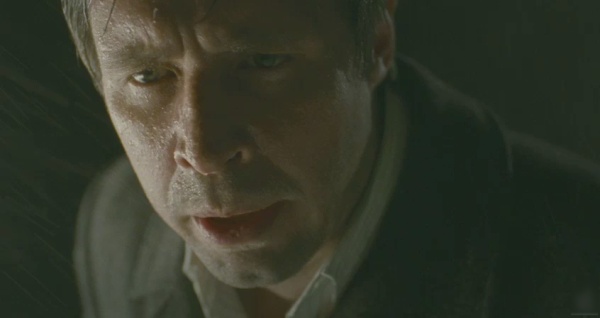[Note: This essay contains no significant spoilers.]
We drive up the motorway, the M1, listening in silence as the stories eventually change, as they move on to two and a half million unemployed, a job lost every two minutes, on to H Blocks and the Eastern Bloc, to a local woman who cut her own throat with a pair of electric hedge clippers.
"Jesus," mutters Murphy as we approach Leeds. "What a fucking place."
—David Peace, Nineteen Eighty
Every now and again, one comes across a film in which genuine aesthetic greatness might be thwarted by various defects in story or style, but which nonetheless works a curiously potent voodoo on the mind. Such a film bores deep into the brainstem, filling one's subsequent hours, days, and weeks with its unsettling visions and vibrations. Such a film may not be a masterpiece under any levelheaded assessment, but that is precisely what renders its profoundly affecting character such a mystery, lending it a touch of the sublime. Now that 2010 is drawing to a close, one work from this year's relatively drab offerings stands out as a superlative example of this phenomenon, wherein a film's peculiar emotional frequency resonates to a degree far out of proportion to its cinematic consequence. That work is Red Riding, a sprawling, perplexing 295-minute excavation of an earthbound Hell. It is a film that has left me hollowed and haunted, unable to right my emotional life after months of cogitation and revisitation.
The Hebrew Scriptures refer to a place for the departed called Sheol, a chthonic region that the Psalmist describes as forgotten by God and cut off from His hand. This is an apposite characterization of the setting of Red Riding, where a spiritual darkness pervades each sad little basement pub and lonely moorland hillock. It is a place without hope: cruelty falls like the gray, ceaseless rain, while corruption seeps into every dwelling and every heart. Netherworlds of such unrelenting bleakness are usually confined to the realms of fantasy, but this particular Sheol is terribly real, and its miserable adornments are all too familiar to anyone over thirty years of age. For Red Riding is a grim tale of 1970s and 1980s Yorkshire, and while the names and faces are slightly fictionalized, the feeling—the atmosphere of the North in this era of mortal terror and broken promises—is chillingly pristine. This is the beguiling paradox that throbs at the heart of the film: Its towering, nearly overpowering mood of desolation transcends time and place, and yet to evoke this mood the filmmakers rely on a setting that is ruthless in its specificity.
David Peace knows this setting well. Born in 1967 and raised in Ossett, West Yorkshire, Peace penned the four Red Riding novels on which Channel 4's film adaptation is based, giving dread form to the woes that scuttled through the landscape of his childhood and adolescence. The novels are murky and rambling things, a fusion of crime thriller conventions and flashy modernism that never quite finds full-throated success in either sphere. Deep within this strange amalgamation, however, Peace unearths a mood as evocative and unsettling as anything in contemporary fiction, literary or otherwise. The Red Riding quartet quivers with a despair so acute that submitting to Peace's prose is an oddly exquisite experience, a plummet into an abyss whose dismal splendor and sheer scale can only be cherished from within. The potency of the saga's atmospherics is exceeded only by their remarkable endurance: across seven protagonists, nine years, and over 1,400 pages, Peace conveys an unremitting abhorrence for the world and everything it contains.
Screenwriter Tony Grisoni takes copious liberties with the narrative details of Peace's desolate epic, above and beyond excising an entire novel (Nineteen Seventy-Seven, the second work in the quartet). Grisoni trims the cast significantly, although his adaptation retains ample characters to suit the film's portrayal of widespread corruption and conspiracy. Roles are amalgamated or written out altogether, while events are rearranged, relocated, and repurposed. The elaborate alterations to the story provide ripe opportunity for an obsessive side-by-side comparison of novel and film, but such evaluation is wholly unnecessary. To be sure, narrative detail is essential to Peace's novels, as its accrual serves to convey the enormity and obscurity of the series' malevolent world, amplifying the reader's sense of vulnerability and powerlessness. However, Grisoni's shrewd and outstanding adaptation comprehends that while the occurrence of complexity is essential to Red Riding, it is feasible to tinker with that complexity without diminishing the work's power.
It is no shame to lose one's way in the labyrinth of Red Riding, a dim realm cobbled together from muddy construction sites, dank bedrooms with peeling wallpaper, and gray corridors that buzz with fluorescent sickness. In Peace's novel Nineteen Eighty, a recurring line hints that the story's density is not an obstacle course to be negotiated: On the dark stair, we miss our step. If our ankle turns on Red Riding's countless sins--the bribes and blackmail, the blowjobs and betrayals, the rapes and murders, and the lies upon lies--we can take cold comfort in the fact that it is by design. In imitation of our Virgils—Eddie Dunford (1974), Peter Hunter (1980), John Piggott, Maurice Jobson, and BJ (all 1983)—our expanding comprehension of this world's dark contours requires that we lose our way, that we stumble and scrape our palms raw. In its affection for a flurry of often bewildering detail, Red Riding echoes the stratagem of two late American masterpieces about real-world crimes, Oliver Stone's JFK and David Fincher's Zodiac. The crucial thematic concerns of those films are not evident from a dry reading of the facts, but emerge only when the facts swirl about in an esoteric true-crime maelstrom (with a liberal dose of fiction). However, where JFK aims to give cinematic form to the conspiratorial mindset of modern American politics, and Zodiac offers an uneasy reproach to our collective need for concrete conclusions, Red Riding's timbre is not political or psychological but fiercely existential. It poses a world replete with madness and wickedness and asks: What can we do but scream?
Such angst-laden queries sprout with distressing ease in Peace's Yorkshire, a land where the damp newspapers bleat of backhand deals, hunger strikes, and bloody ball-peen hammers. Grisoni and the film's three directors—Julian Jarrold (1974), James Marsh (1980), and Arnand Tucker (1983)—are all British natives or emigrants, and they are vigorously aware of the distinct, fearsome aura that Peace's setting demands. Indeed, the novelist is, in a sense, the film's ambivalent, fearful auteur, and the success of Red Riding is due in no small part to how superbly the filmmakers translate the trappings and essence of Peace's world to celluloid (or pixels, in Tucker's case). The Yorkshire of Red Riding is an exaggerated vision of the North—uglier, meaner, more rotten in its teeth and heart—but the amplification is slight. Within Red Riding's warped boundaries, the jagged malaise of the Wilson and Thatcher years feels uncommonly genuine and urgent, bestowing on the film a formidable transporting quality that few period pieces can boast. Sinking into the film's abyssal folds renders the past decades of real-world history as little more than a dream. Here, the Devil still cruises the M1 in a rusty Transit van, and the future is still awash in Soviet-born nuclear fire.
Setting is the central component of Red Riding's dread spell, and the film's sustained and persuasive attentiveness to place is all the more striking given that the three chapters employ distinct production designers (Christina Casali, Tom Burton, and Alison Dominitz) and cinematographers (Rob Hardy, Igor Martinovic, and David Higgs). The film's spaces are familiar: sitting rooms, offices, pubs, restaurants, garages, holding cells, hotel rooms, hospital wards, alleyways, vacant lots. More than mere backdrops, these spaces comprise a visual vocabulary of menace and desperation. "All great buildings resemble crimes, they say," Yorkshire Post reporter Barry Gannon (Anthony Flanagan) muses provocatively, but in Red Riding every building seems to be a transgression wrought in cheap laminate, linoleum, aluminum, and concrete. Every room is drained and shabby, yellow with cigarette smoke, full of worn, chipped furnishings to accommodate worn, chipped souls. Fissures—visible and invisible—run through everything, even Shangri-La, the lavishly designed abode of construction magnate John Dawson (Sean Bean). Hideous, modern buildings loom over the landscape, monolithic testaments to the foolish sanguinity of humankind's optimism. Rain-slick motorways snake over the lonely moors, stitching together grimy cities and shitty little towns, while in the distance nuclear cooling towers belch Christ-only-knows-what into slate skies. In surveying these sights, one gradually becomes sensitive to the peculiar black magic of Red Riding: the cruel fidelity of its vision establishes that we are in a real place, and yet the stench of Purgation is everywhere.
Nearly as essential are the visages of the vast ensemble cast. Many of the performers seem to have been tapped solely on the basis of their expressive eyes, brows, or lips. Critics might justly dismiss the casting of the film for its reliance on expedient shorthand in lieu of deeper characterization, but given the vast and multifaceted character of Red Riding's tale, the faces and voices provide a vital means of orienting the viewer. They are landmarks in a sea wracked by confusion and alienation: Dawson's menacing smirk; Bill Malloy's (Warren Clarke) bullfrog scowl; Jack Whitehead's (Eddie Marsan) splendid sneer; Michael Myskin's (Daniel Mays) doughy countenance and slack grin; Martin Laws' (Peter Mullan) twinkling eyes; Bob Craven's (Sean Harris) oily mustache on a weasel mug; BJ's (Robert Sheehan) uneasy scoffs and glances. Then there are the women, who all wear the same expression of apprehension and simmering bitterness, the look that eventually settles over the faces of all Yorkshire lasses after hearing the same hissed words—"cow," "slag," "bitch," "whore"—relentlessly, day after miserable day, year after miserable year. Observing the women, one can see how such a place could birth the Ripper: the way Paula Garland (Rebecca Hall) pulls her thin sweater over her thin frame; the way Helen Marshall (Maxine Peake) is perpetually averting her eyes; the way Libby Hall (Julia Ford) inclines her head and smiles a little too quickly. Red Riding is too immense and impressionistic to qualify as a "performance film," and yet every one of its performers seems remarkably attuned to the tale's dense, pungent miasma. Every sideways look and nervous swallow, every heaving sigh and spitting retort contributes to the verisimilitude of the setting, if not the story.
What of the story, then? It is a dizzying thing, resistant to the sort of forensic scrutiny that the Yorkshire detectives might apply, where they not complicit in the tale's ghastly crimes. Like the policemen in David Simon's episodic urban tragedy The Wire—whose glacial, accretive narrative and moral ambiguity mark it as a cousin to Red Riding—one might sketch an organizational chart for the film and populate it with names, places, dates, crimes, even tidbits of evidence in tiny plastic bags. No earth-shattering revelation would be forthcoming from such an exercise, however. By the conclusion of Red Riding, one knows (with some uncertainty) who extorted whom, who molested whom, and who murdered whom, but there is no shock or outrage, merely a vague sense that what has come to pass is terrible, just as everything that happens in this forsaken Yorkshire is terrible. Even Christmas, it turns out, is full of raging fires and moldering corpses.
Moreover, should one persist in sketching those lines of connection and then take a step back, one would discover that the arrows and names have encompassed the whole hideous world. Somewhere, an arrow will point to each of us. As Barry Gannon declares, "Everything's linked. Show me two things that aren't connected." Eddie Dunford (Andrew Garfield), evincing the sort of naïveté that is the singular province of the hot-blooded and the ambitious, claims that he cares about the murder of children, not shady real estate deals and political corruption. ("If it bleeds, it leads.") Spotlessly clean Manchester copper Peter Hunter (Paddy Considine) goes to Leeds with crystal-clear mission parameters: expose the Yorkshire police blunders that have permitted the Ripper to butcher thirteen women. Each of these men suffers form the delusion that their search for the truth can be constrained by boundaries, even as Red Riding proves time and again that borders are mutable and porous. On the dark stair, we miss our step, stumbling across borders without even realizing it.
Eddie and Hunter are too heedlessly zealous and too convinced of their own righteousness to penetrate Yorkshire's bulwarks. It is no accident that the truth is finally cracked open by defeated, self-loathing lawyer John Piggott (Mark Addy), a man the North has ground down to a wad of sweaty nothing, and by crooked detective Maurice "The Owl" Jobson (David Morrissey), who sold his soul so long ago that its fresh stirrings seem like the slurred rumblings of a drunken enemy. Piggott and Jobson—and poor, wounded BJ—understand what Eddie and Hunter cannot. All of Yorkshire's sins are connected, and they all sprout from the same place: the Red Riding, a spiritual wasteland not found any map of the county, ancient or modern. It leaves its traces on greasy takeaway wrappers and sticky skin magazines. It bubbles up wherever a weary mother catalogs fresh drywall dents and bruises; wherever unlucky hustlers taste concrete and broken teeth; wherever wicked men gather to raise glasses to their venality and greed, as though such failings were gleaming medals.
Viewers with little patience for unrelenting gloom may be skeptical of Red Riding's worth as a work of entertainment. The films relies upon the tropes and patterns of crime thrillers, but nothing in its formal or thematic character suggests a whodunit gewgaw unfolding for our pulse-quickening titillation. This is not cinema as diversion, but a five-hour hymn to the awfulness of the world, with little in the way of nuance or qualification. What distinguishes Red Riding from the thickheaded nihilism embraced by most contemporary horror films (or, for that matter, underlying most Hollywood fare) is the sheer poetry of its grim vision. It is the most engrossing and haunting kind of art, in which loveliness is not a conspicuous surface feature but an emergent phenomenon, the product of foul raw materials that do not suggest such potential. Admittedly, Red Riding's loveliness is the blackest sort conceivable, but it is loveliness just the same. Grisoni's adaptation alters the unbearably bleak conclusion of Peace's novels, providing some semblance of release and salvation for the characters, but the message of Red Riding is not that happy endings can still occur in this fallen world. Rather, the film's meaning is revealed by the very existence of the film: even in Sheol, there is splendor.















